PYEONGCHANG, S. Korea — When we travelled to South Korea to test out the new Hyundai Santa Fe, we also got a chance behind the wheel of the new hydrogen-powered Nexo fuel-cell SUV. Hyundai unveiled the Nexo at CES in January as a replacement for the Tucson Fuel Cell, which logged miles and gathered data in 18 countries over the course of its generation. The Nexo is an improvement: It's more efficient, packed with smarter driver assistance technologies and, in our opinion, is more attractive.
With a clean an uncluttered exterior, it has a familiar crossover profile, but the front end, is a little more unique with a large grille and über-thin lighting tucked high under the front of the hood. The rear end offers a lot of blank sheet metal, which looks fetching in white. Aerodynamic vents behind the rear quarter windows open up at the back of the car beneath a sporty-looking spoiler.
But it's the clean, sustainable future that its hydrogen fuel may provide that's most important. Which is not to diminish the benefits battery electric cars offer in the interim — and likely for the foreseeable future — but renewable electricity is intermittent. So how does one store massive amounts of clean electricity for long periods to use when it's not readily available? Hydrogen electrolysis – using an electric current to decompose regular water into oxygen and hydrogen.
The beautiful thing about the abundant element is that it can be converted back to electricity, either on a grid-scale, or in the fuel cell of a passenger vehicle. (The less beautiful thing is how to store hydrogen safely, but that's another story.)


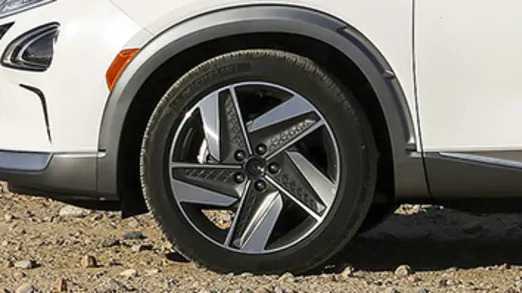

Our first stint inside the vehicle took place in the back seat, where we had plenty of legroom and clean surroundings. The interior was white and grey with matte silver metallic trim. The plastics in the Nexo aren't particularly soft, but somehow Hyundai makes them look premium with fine grains and patterns — one of the tricks Hyundai uses to make its affordable cars feel like higher-end automobiles. We were comfortable back there, especially with rear seat heaters to ward of the winter chill in the Korean mountains as we drove past the Winter Olympics in PyeongChang.
When it came our turn to get behind the wheel, we felt right at home in the comfortable driver's seat. The steering wheel was attractive in its two-tone leather, and smooth to the touch. The digital instrument panel and touchscreen extending to the right of it offered high definition images, crisp colors and ultra-quick response. The overwhelming number of buttons on the center console threw us off, though. It reminded us of a control panel for some sort of spaceship.
Driving across a foreign country, we were put at ease by the robust navigation system. Not only did it show and tell us where to go, it let us know what the speed limit was, and even identified the locations of speed cameras, something the Santa Fe was kind enough to do for us as well. Distances were in the metric system, which took some getting used to, but a shrinking bar on the nav screen helped us count down the actual distance to our next turn. We learned to focus on that rather than the voice telling us to "Turn now," which was always a little too early.
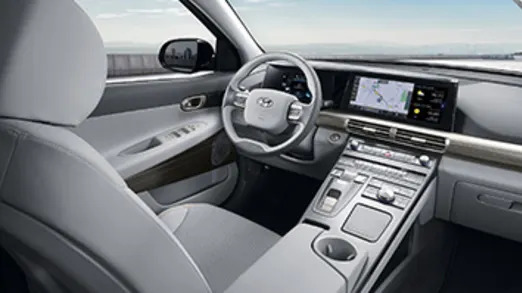
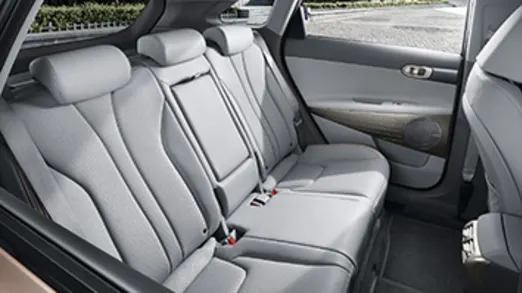
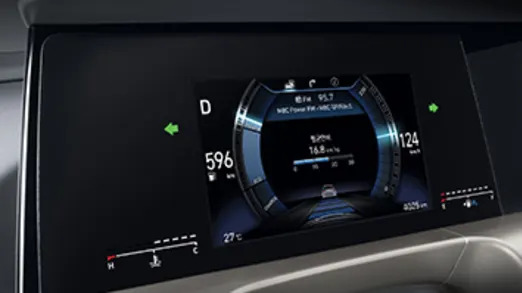
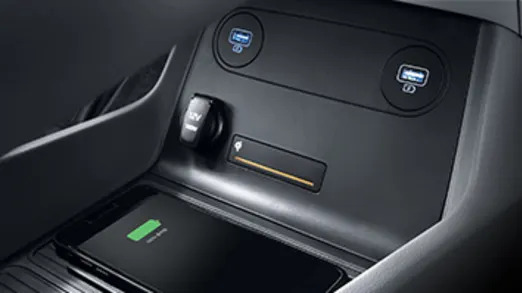
The Nexo wasn't quick, but it was smooth, and the quiet, linear acceleration was satisfying. Most of our driving took place on the highway, so there wasn't of lot of acceleration or braking or cornering. We just aimed ahead, avoided other cars, and checked every once in a while to make sure we hadn't taken a wrong turn toward the northern border. For this sort of driving, the quiet, calm Nexo was a pleasant companion.
Nexo is equipped with a number of driver assist features which we found helpful. Adaptive cruise control helped us keep to the speed limit (those cameras are everywhere) and maintain following distance, while the lane minder kept the car stable and centered. When we did go to switch lanes, touching the signal pulled up a camera feed on from the side of the vehicle, showing our blind spot in the center of the instrument, cluster. This is similar to Honda's system, but this covers both sides, the display is better placed, and the picture is more clear and full. In the Nexo, we found it far more helpful than distracting, and we'd like to see it come to more vehicles.
When we finished our drive and exited the car, we heard a sound come from underneath the car that was not unlike the hatch of the Millenium Falcon's hatch opening, only quieter. Our eyes were drawn to the ground as a few small puddles of water trickled downhill toward the edge of the driveway. That water — unadulterated H2O — was the only "emissions" accumulated during our quiet drive through the mountains of S. Korea.
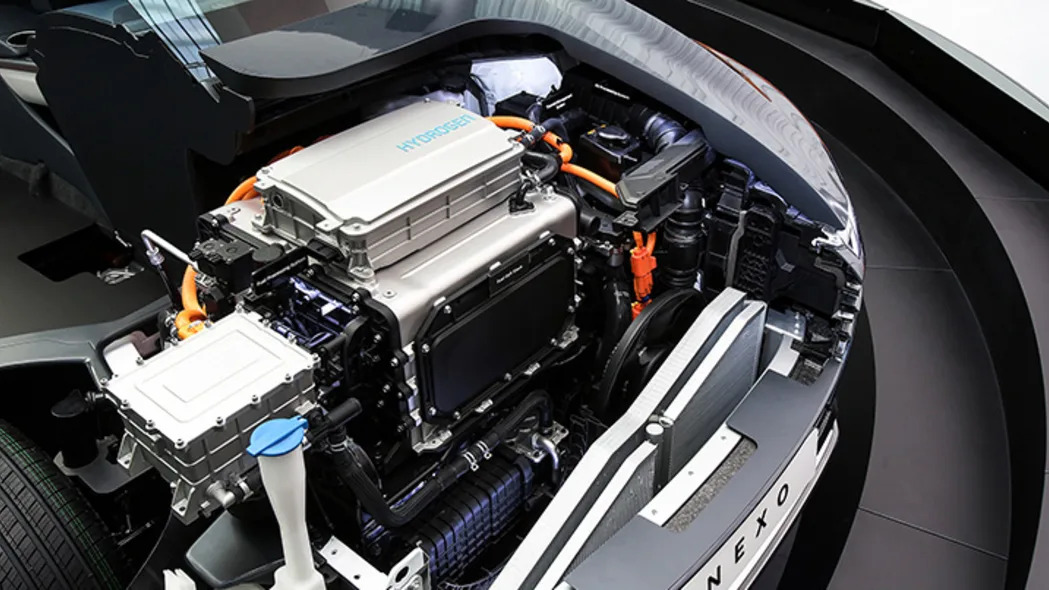
The day after our highway jaunt, we were back in PyeongChang. This time, we were actually at the Olympics, not just cruising past them. In the middle of it all, Hyundai was offering people — gathered media and the curious public alike — rides in a Level 4 autonomous version of the Hyundai Nexo. We hopped in the back for a brief loop.
We reached a certain point, the drive loop began and the engineer in the driver's seat took his hands off the wheel. We watched the screen that displayed the sensor data as the car recognized stationary objects, curbs, lane markings buses pulling out in front of it, pedestrians waiting to cross the street. The amount of data it processed was impressive to see in real time, even when driving through a tunnel meant it lost its GPS mapping for a brief period.
The automated system drove safely, moving over gently when an oncoming vehicle crossed the centerline, navigating a roundabout and stopping for signals without a hiccup. The car responded so smoothly, we only noticed a difference later when the driver took over again and drove like a human. Under automation, the Nexo saw far ahead, predicting future moves like a chess computer. Humans struggle to operate at this level of awareness. It was a sunny day with clear roads, but the traffic was a little unpredictable. The roads were narrow, with a lot of cars, buses and pedestrians around. As a human, it wouldn't have been a problem for us, but we can think of individuals we know who would have been uneasy driving in these circumstances, even if the street signs were posted in their native language.

It's not perfect tech yet (and nobody should be faulted for thinking automated driving has a way to go before it is). For one thing, the car can't yet distinguish emergency vehicles from any other, but Hyundai is working on incorporating sound into the sensor suite to recognize sirens. Still, we witnessed no failures, or even less-than-great driving during our brief ride. In fact, we were impressed with the way the system was able to account for the imperfect driving of other vehicles on the road. We'll have to have a lot more seat time in a lot more conditions as guinea pigs in AVs before we're ready to cancel our kid's driver's ed classes, but that seat time is coming soon.
The automotive world is changing, and Nexo is a great example of that, whether driven by a human or AI. A day when the average person can drive a fuel cell vehicle (regardless of region) or an autonomous one may still be far off. Even Korea is still lagging far behind places like Japan and California, but promising initiatives are planned for the Northeastern U.S. and swaths of Europe. For reference, California currently has over 30 hydrogen stations in operation, a number expected to double by the end of next year. Japan is planning a giant push to showcase hydrogen — and autonomous cars — at the Olympics in 2020.
While those involved with developing the hydrogen economy are convincingly certain of its eventuality, the rest of us have little choice but to tinge our wait-and-see attitude with optimism. We're glad, though, to see how the technology is advancing, regardless of the timeline. Even more importantly, companies like Hyundai are putting thought and effort into actually making these vehicles good to use. As much as the Nexo is a demonstration of the future, is also a reassurance from Hyundai that that future doesn't have to suck.
Related Video:










Sign in to post
Please sign in to leave a comment.
Continue